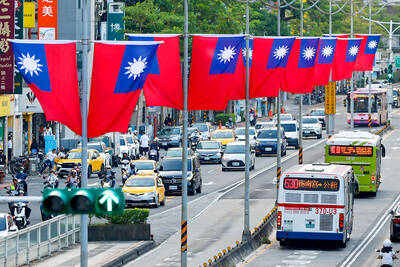Starting on Dec. 31, people would be able to purchase 10 medical-grade masks every two weeks at NT$4 per mask through the government’s rationing system, the Central Epidemic Command Center (CECC) said yesterday as it reported two new imported cases of COVID-19.
The rules governing the rationing system have been modified a few times since its launch on Feb. 6, based on changing circumstances, and they would be modified again, as the nation’s mask manufacturing capacity has significantly increased, said Minister of Health and Welfare Chen Shih-chung (陳時中), who heads the center.
The number of masks a person can purchase at National Health Insurance-contracted pharmacies would be increased from nine every two weeks to 10, both for adults’ and children’s masks, Chen said.
The masks would be put in packs of 10 by the manufacturers, so pharmacists would no longer need to package them, he said.
While the current price is set at NT$45 for nine masks, the new price would be NT$40 for 10 masks, he said.
“You would get one more mask, but pay NT$5 less,” Chen said.
Packaging on the masks would mark the expiration date, the medical equipment license number, the manufacturer’s name and contact information, and other related information, in accordance with the Pharmaceutical Affairs Act (藥事法), he said.
People who have questions about the mask quality can contact the manufacturers through the contact information printed on the package, the CECC said.
People who preorder masks online for pickup at convenience stores and chain retailers would be able to preorder from Dec. 21 to 30, and pick up the masks from Jan. 4 to 17, Chen said, adding that they would have to pay a shipping fee of NT$7.
Chen said the two new imported cases are a Burmese in his 40s and an Indonesian in his 40s, who came to Taiwan for work on Nov. 22 and Nov. 21 respectively.
Neither of them showed symptoms and they both stayed in a quarantine hotel after arrival, he said.
They each underwent a paid-out-of-pocket polymerase chain reaction (PCR) test after ending their quarantine on Monday, and the results returned positive yesterday, he said.
CECC specialist advisory panel convener Chang Shan-chwen (張上淳) was asked to comment on case No. 719 reported on Tuesday, a Taiwanese man who traveled to China’s Zhejiang Province in September, returned home on Nov. 22 with a negative PCR test report from within three days before leaving for Taiwan, but developed symptoms during quarantine on Friday.
The case raised concerns as to whether the man could have been infected in Taiwan, as the onset of symptoms began 12 days after the man returned home and the PCR test result suggest a recent infection.
The CECC on Tuesday said it would conduct a viral genome sequence of the virus strain in his body to clarify the possible source of infection.
Chang yesterday said a long incubation period of 12 days is possible, although relatively rare, and that comparing virus genome strains is the scientific approach to better determine the infection source.
However, a difficulty in genome comparison is that Taiwan has had no recent local infections, and China has not publicized the viral genome sequence of its locally transmitted cases for a long time, so epidemiologic inference and contact tracing are also being conducted, he said.
Chang said Taiwan has not detected any locally transmitted cases for a long time, but sporadic local transmitted infections have been reported in China, and some cases were reported at Shanghai’s Pudong International Airport on Nov. 22, when the man returned to Taiwan from the airport.
Contact tracing found that the man took off his mask to eat at the airport before boarding, did not leave his quarantine hotel room in the 12 days after arriving in Taiwan, and no confirmed cases of COVID-19 infection have been reported among the guests who previously stayed at the hotel, he said.
There is a relatively low chance that the man contracted the disease in Taiwan, he added.

The Taipei Mass Rapid Transit (MRT) Wanda-Zhonghe Line is 81.7 percent complete, with public opening targeted for the end of 2027, New Taipei City Mayor Hou You-yi (侯友宜) said today. Surrounding roads are to be open to the public by the end of next year, Hou said during an inspection of construction progress. The 9.5km line, featuring nine underground stations and one depot, is expected to connect Chiang Kai-shek Memorial Hall Station to Chukuang Station in New Taipei City’s Jhonghe District (中和). All 18 tunnels for the line are complete, while the main structures of the stations and depot are mostly finished, he

Taipei is to implement widespread road closures around Taipei 101 on Friday to make way for large crowds during the Double Ten National Day celebration, the Taipei Department of Transportation said. A four-minute fireworks display is to be launched from the skyscraper, along with a performance by 500 drones flying in formation above the nearby Nanshan A21 site, starting at 10pm. Vehicle restrictions would occur in phases, they said. From 5pm to 9pm, inner lanes of Songshou Road between Taipei City Hall and Taipei 101 are to be closed, with only the outer lanes remaining open. Between 9pm and 9:40pm, the section is

The first global hotel Keys Selection by the Michelin Guide includes four hotels in Taiwan, Michelin announced yesterday. All four received the “Michelin One Key,” indicating guests are to experience a “very special stay” at any of the locations as the establishments are “a true gem with personality. Service always goes the extra mile, and the hotel provides much more than others in its price range.” Of the four hotels, three are located in Taipei and one in Taichung. In Taipei, the One Key accolades were awarded to the Capella Taipei, Kimpton Da An Taipei and Mandarin Oriental Taipei. Capella Taipei was described by

The Taipei Economic and Cultural Office in Vancouver, Canada, on Saturday hosted a reception to celebrate Double Ten National Day. Conservative Canadian lawmaker Marc Dalton called Taiwan a “beacon of courage and resilience in the face of rising authoritarianism,” according to a post on the Taiwan in Vancouver Facebook page. Also in attendance were fellow conservative caucus members Tako Van Popta and Chak Au, who said that Taiwan plays an “indispensable role” in ensuring global peace, prosperity and stability due to its strategic position in the Indo-Pacific region, it said. Canadian lawmaker Michael Cooper also recorded a message wishing Taiwan a